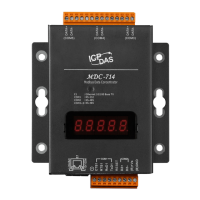Copyright © 2014 ICP DAS Co., Ltd. All Rights Reserved. ∗ E-mail: service@icpdas.com - 28 -
Polling Definition
The Polling Definition is used to define Modbus commands to read data from the slave devices.
Before attempting to configure the parameters for the Polling Definition, be sure to check the
COM port number that the target device is connected to, the Modbus ID setting for the target
device, and the function code, starting address, and the quantity for reading data.
Each Polling Definition consists of 8 parameters listed as below:
Defines the type for a polling definition. In the MDC-700, it provides three types:
“*”: Asterisk symbol means that this is a valid polling definition. The MDC-700 will
assign local register for data defined in the definition and save the polled
data to the mapping local register.
“-”: Minus sign means that this is a disabled polling definition. The MDC-700 will
assign local register for data defined in the definition but will not poll data.
“”: Empty means that this is a null polling definition. The MDC-700 will neither
assign local register for data defined in the definition nor poll data.
Defines the COM port number to which the slave device is connected. The COM
port number is from 1 to the total number of COM ports on the MDC-700.
Defines the identification of the remote slave. The valid range is from 1 to 255.
Defines the request function code. A valid code can be 1 (Read DO), 2 (Read DI), 3
(Read AO) or 4 (Read AI) depending on the I/O features of the slave device.
Defines the starting address, i.e. the address of the first register specified.
The available range is from 0 to 65535.
Defines the quantity of registers to be read. The available range is from 1 to 125.
Defines which data will be read while a timeout error is occurred:
0: the exception code
1: the latest data before the timeout error occurred
2: a preset value
Defines the preset value applied when the TimeoutEventProcess is set to 2.

